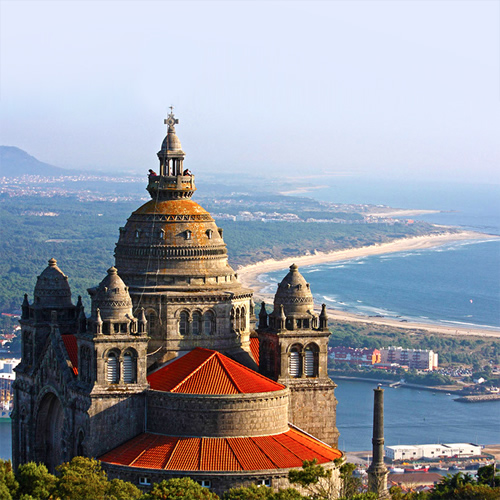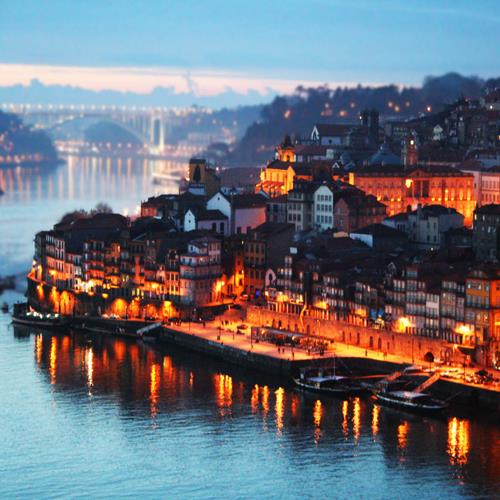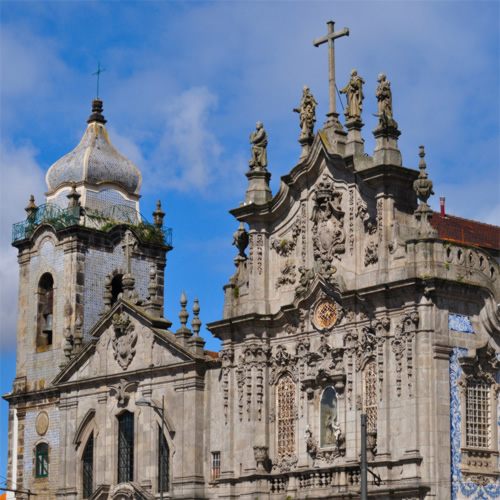COSTA VERDE - TOWNS AND VILLAGES

Caminha
Caminha (pop. 16,000) is the northernmost town in the Costa Verde region, situated on the Minho River just 1.2 miles from the Atlantic Ocean. The Minho River is less than a mile wide between the ferry terminal in Caminha and the ferry terminal at Camposancos, located in Spanish Galicia. The ferry trip between Caminha and A Guarda, also on the Spanish side of the river, is very short, only about five miles.
Caminha grew in the Middle Ages after King Afonso III commissioned the construction of Caminha Castle, in the 13th century. As Caminha sat on the border of Galicia, it became an important military stronghold on the Portuguese frontier. Once an important trading port, over time much of Caminha`s industry moved southward to Viana do Castelo. Today Caminha`s economy is heavily tied to tourism. Sights in Caminha include Caminha Castle, the Igreja Matriz de Caminha (built in the Gothic/Renaissance hybrid styles), and the Medieval Old Town centered around the Rua Direita.

Vila Praia de Ancora
Vila Praia de Ancora (pop. 4,820) sits in a valley bordered by the Serra D`Arga mountains to the north, near Caminha, and by the Monte de Santa Luzia, north of Viana do Castelo and to the south of Vila Praia de Ancora. The town sits on the Atlantic Coast at the mouth of the Ancora River. Many of the sights and much of the action revolve around the seaside road, which is called Avenida Campo do Castelo and Avenida Doutor Ramos Pereira. South of town, it becomes Rua 31 de Janeiro. Noteworthy sights include the Dolmen of Barrosa, Forte do Cao, Igreja Matriz de Vila Praia de Ancora, and Forte de Ancora.


Viana do Castelo
Viana do Castelo (pop. 88,000) is considered one of the most important cities in the north of Portugal. Sitting on the Atlantic Coast and on the mouth of the Lima River, Viana (as it`s called by locals) was long the first line of defense in protecting the coastline and valley around the town, and this tradition can be seen at such points of interest as the Forte de Santiago da Barra and the Forte da Areosa just to the city`s northwest. Even today, the impressive Santuario de Santa Luzia, albeit religious in nature, stands watch over the city below.
The historic city center reached its golden age in the eighteenth and nineteenth centuries, and even today it is still evident in the wide, tree-lined avenues leading to Rococo-era mansions with distinctly Manueline features. The area between the Praca da Republica and the riverside marries history with the modern day, best illustrated by the imposing presence of the Monument to Freedom, built 25 years after the end of the Estado Novo.
Most of the sights in Viana do Castelo are situated in a compact area that`s roughly two-fifths of a mile wide and four-fifths of a mile long. The sights around the Santuario de Santa Luzia are all in a radius of approximately a quarter-mile. It is particularly easy to reach all the sights in and around the Praca da Republica: there are about ten points of interest within a (figurative) stone`s throw of the square. If you would like to walk for exercise, consider the areas around the Largo 5 de Outubro, such as the Jardim da Marina and the Jardim da Marginal.

Esposende
Esposende (pop. 9,000) is the next town going south on the Costa Verde from Viana do Castelo. Esposende is well-known for its Roman-style folk costumes and windmill villages sitting on a settlement south of town called Apulia (named after the region in Italy). Esposende`s compact town center is located at the mouth of the Cavado River, with the Litoral Norte Natural Park separating Esposende from the waters of the Atlantic Ocean. The Forte de Sao Joao Baptista is located at the northern end of the Cavado River`s mouth.


Povoa de Varzim
Povoa de Varzim (pop. 63,000) is the fourth-largest city in Northern Portugal and on the Costa Verde. It is the northern terminus of the Porto Metro, and is considered the northernmost suburb of the Greater Porto region, although the economies of Povoa de Varzim and Vila do Conde to the south are self-sufficient in their own rights and are not tied to those of Porto`s.
Povoa de Varzim was settled over four thousand years ago, and by the time of the Roman occupation of Portugal, a large castro was built close to the modern-day city called Cividade de Terroso. A town of shipbuilders and merchants, Povoa de Varzim thrived in particular during the Portuguese Age of Discovery, corresponding roughly to the fifteenth, sixteenth and seventeenth centuries. The fishing, processing and canning industries supplanted shipbuilding by the end of the seventeenth century, and Povoa de Varzim grew to become the largest fishing port by volume in the north of the country. By the end of the nineteenth century, Povoa de Varzim became well-known for its spas and beach resorts, becoming the first beach resort of its kind in Northern Portugal. The resort town`s crown jewel came in 1934, when Casino de Povoa opened. Casino de Povoa is one of the largest casinos in the country.
Sights are largely situated in between the northern west-east artery, which is called Rua Gomes de Amorim west of Praca Marques de Pombal, and Rua Almirante Reis to the east. The southern west-east artery, running parallel to the coastline, is called the Marginal Atlantica, also known by the names Avenida dos Banhos, Avenida dos Descobrimentos and Avenida Infante Dom Henrique. Noteworthy points of interest include the aforementioned Cividade de Terroso, Casino de Povoa, the Ethnography and History Museum, the Igreja da Nossa Senhora da Lapa and the Lapa lighthouse, Garrett Theatre, the Monastery of Rates, and the Rua da Junqueira shopping district.

Vila do Conde
As the Marginal Atlantica heads south past Avenida Doutor Antonio Bento Martins Junior, Povoa de Varzim turns into the town of Vila do Conde (pop. 36,000). Many of the sights in Vila do Conde are located in the area between the Marginal Atlantica (this far south it also takes the name Avenida do Brasil) and the N13 road, also called Avenida 5 de Outubro. The Praca da Republica is located to the west of the N13 before it crosses the Ave River.
The Avenida Marginal loops around the eastern side of the mouth of the Ave River to become Avenida Julio Graca. Other major streets include Rua Conde Dom Mendo, Avenida Doutor Artur da Cunha Araujo, Avenida Doutor Joao Canavarro and Rua 25 de Abril. Sights in Vila do Conde include the Igreja Matriz, the Monastery and Aqueduct of Santa Clara, the Capela do Socorro, the Forte de Sao Joao, and the Capela da Nossa Senhora da Guia.



Porto
Porto, `the Invincible City,` is the second-largest city in the country and is one of the oldest European cities, having been conquered by the Celts, the Romans and the Moors, all before the 11th century. Porto (pop. 237,000) was long valued as a trading outpost adjacent to the Atlantic Ocean; its location on the River Douro is just three miles from the wide open sea. The city`s long history is evident when you stroll the winding back streets of the city center, which was named a UNESCO World Heritage Site in 1996. Porto is also a hub for shopping, music, art, entertainment, and culture for the north of the country.
For the purposes of a self-drive trip of the Costa Verde as recommended by TripMasters, you may not have time to see all that Porto has to offer, but if you do get to spend a day here, here are some of the highlights:
First, be sure to enjoy a Francesinha sandwich (a Porto delicacy!) and a chá (tea) at the numerous cafes around town. See some of the breathtaking architecture and history at sights like the Porto Cathedral, Porto City Hall, and the Muralha Fernandina. Shop for hours at the shops in Baixa and Cedofeita and the Rua Miguel Bombarda; and sample a glass or two of delicious port wine (the area around Porto is world-renowned for its port!).
Many sights in Porto are located within walking distance from the city center. You will find that most sights in the city are within a one-mile radius, although some may be further afield. Our recommendation is to lose yourself in the winding streets of old Porto, and to utilize the Porto Metro and other modes of public transportation when venturing further out. The four largest Porto Metro stations are Senhora da Hora, Trindade, Campanha and Estadio do Dragao. All four stops connect with cities along the Costa Verde from Povoa de Varzim down to Vila Nova de Gaia. The Funicular dos Guindais spans the Douro River and connects Porto with Vila Nova de Gaia across the way.


Vila Nova de Gaia
Vila Nova de Gaia (pop. 178,000), once considered a neighborhood of Porto, is now its own city, the second-largest in the entire region. Vila Nova de Gaia located directly across the Douro River from Porto, linked by the Funicular dos Guindais and the Ponte de Dom Luis. When people think of the delicious port wine that Porto is famous for, they are actually thinking of Vila Nova de Gaia, where many of these vineyards store reserves and hold private and public port tastings.
The area`s close proximity to Porto and the city center means that the city of `Gaia`, as natives refer to it, has become a comfortable suburb, featuring great shopping, fine dining, and of course, world-renowned port wine lodges (underground tunnels which store and age the delicious port). Over 50 port wine distributors are based here, and over a dozen are located within a stone`s throw of the waterfront area (Avenida de Ramos Pinto and Avenida Diogo Leite). Also of note, Vila Nova de Gaia is home to the Mosteiro da Serra do Pilar, a former monastery serving the Order of Saint Augustine. The views from the domed roof are some of the best in all of the region.

Espinho
Espinho (pop. 9,800) is the southernmost city on the Costa Verde, just south of Porto and Vila Nova de Gaia. Espinho was believed to have been settled before the Common Era, and by the time of the Roman conquest, there was a castro built here called the Castro de Ovil; the ruins are available for tourists to visit. After a few hundred years, the area was abandoned and not permanently settled again until 1776, making it a particularly young city with the exception of the castro. Perhaps the most noteworthy points of interest are the massive Igreja Matriz, built in 1930 in the Revivalist style; and Casino Solverde, one of the largest in Northern Portugal.